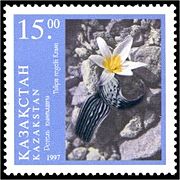
Tulipa turkestanica, the Turkestan tulip, is a species of tulip native to Central Asia. It was first described by Eduard August von Regel in 1873 as a variety of T. sylvestris, then elevated to full species status two years later.

This is a survey of the postage stamps and postal history of Kazakhstan.

Tulipa gesneriana, the Didier's tulip or garden tulip, is a species of plant in the lily family, cultivated as an ornamental in many countries because of its large, showy flowers. This tall, late-blooming species has a single blooming flower and linear or broadly lanceolate leaves. This is a complex hybridized neo-species, and can also be called Tulipa × gesneriana. Most of the cultivars of tulip are derived from Tulipa gesneriana. It has become naturalised in parts of central and southern Europe and scattered locations in North America.
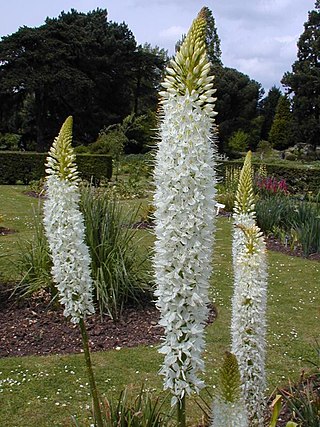
Eremurus is a genus of deciduous perennial flowers in the family Asphodelaceae. They are also known as the foxtail lilies or desert candles. They are native to eastern Europe in, and temperate Asia from Turkey to China, with many species in Central Asia.

Tulips are spring-blooming perennial herbaceous bulbiferous geophytes in the Tulipa genus. Their flowers are usually large, showy, and brightly coloured, generally red, orange, pink, yellow, or white. They often have a different coloured blotch at the base of the tepals, internally. Because of a degree of variability within the populations and a long history of cultivation, classification has been complex and controversial. The tulip is a member of the lily family, Liliaceae, along with 14 other genera, where it is most closely related to Amana, Erythronium, and Gagea in the tribe Lilieae.
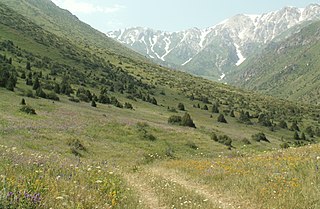
The Aksu-Zhabagly Nature Reserve is the oldest nature reserve in Central Asia. It is located in the southern province of the Republic of Kazakhstan. It covers the north-western mountain chains of the Tian Shan. Its name is derived from the biggest river in the area, the Aksu, and the mountain chain Zhabagly which is located in the northern part of the area.

The Kungey Alatau, also spelled Kungoy Ala-Too, and Kungey Alataw, is a mountain range, which forms the northern Tien Shan with Zailiyskiy Alatau. The word "Alatau" or "Ala-too" means "variegated mountains", a designation indicating a pronounced high-altitude zone of mountains, partly white due to snow, partly dark on snowless areas. The word "Kungey" or "Kyungei" means "the side facing to the South".

Zinaida Petrovna Botschantzeva was a Soviet and Russian botanist, cytologist, embryologist, and professor of the Tashkent university.

Tulipa urumiensis, the late tulip or tardy tulip, is a species of flowering plant in the family Liliaceae. It is a perennial growing from a bulb. By some sources the accepted name is Tulipa tarda. It has a leathery tunic that is glabrous on the inside. It has up to seven linear green leaves that can be up to 20 cm long. The stem is between 4 and 20 cm long. The yellow flowers have white tips, anthers and stamen are yellow.

Tulipa suaveolens, synonym Tulipa schrenkii, the van Thol tulip or Schrenck's tulip, is a bulbous herbaceous perennial of species of tulip (Tulipa) in the family of the Liliaceae. It belongs to the section Tulipa. It is the probable wild ancestor of the garden tulip.
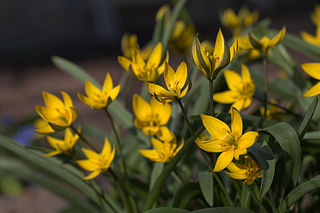
Tulipa dasystemon, synonym Tulipa neustruevae, is a bulbous herbaceous perennial species of tulip (Tulipa) in the family Liliaceae. It belongs to the section Biflores.

Tulipa sylvestris, the wild tulip or woodland tulip, is a Eurasian and North African species of wild tulip, a plant in the lily family. Its native range extends from Portugal and Morocco to western China, covering most of the Mediterranean and Black Sea Basins, and Central Asia. The species is also cultivated as an ornamental and naturalized in central and northern Europe as well as a few scattered locations in North America. It was first recorded as being naturalised in Britain in the late 17th century.

Tulipa alberti, or Albert's tulip, is a species of flowering plant in the family Liliaceae. It has long reddish, orange or pink flowers. It comes from the mountains of Central Asia.

The taxonomy of Tulipa places the genus in the family Liliaceae, and subdivides it as four subgenera, and comprises about 75 species.
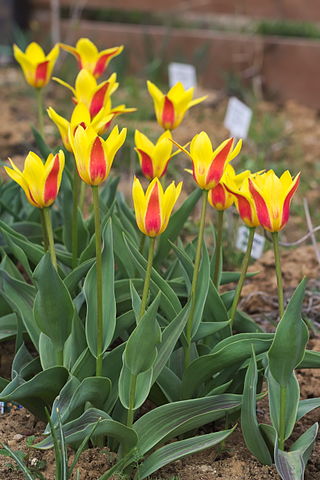
Tulipa kaufmanniana, the water lily tulip, is a species of tulip native to Central Asia.

Tulipa greigii, is a species of tulip native to Central Asia and Iran.

Tulipa kolpakowskiana, or Kolpakowsky's tulip, is a species of tulip native to Afghanistan, Kazakhstan, Kyrgyzstan, and Xinjiang in China. Its petals display a floral iridescence which is perceived by bumblebees. It has gained the Royal Horticultural Society's Award of Garden Merit. Its ultimate height and spread ranges from 0.1 to 0.5 metres and 0 to 0.1 metres, respectively.
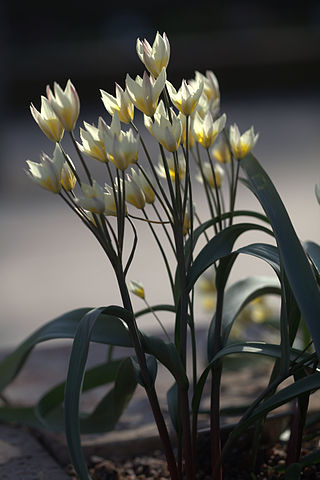
Tulipa bifloriformis is a species of tulip native to Central Asia. Its dwarfed 'Starlight' cultivar has gained the Royal Horticultural Society's Award of Garden Merit.
Iljinia is a monotypic genus of flowering plants belonging to the family Amaranthaceae. It only contains one species, Iljinia regelii(Bunge) Korovin ex Iljin

The Chu-Ili Range is a mountain range in Kazakhstan. Administratively it is part of the Almaty and Zhambyl regions.

